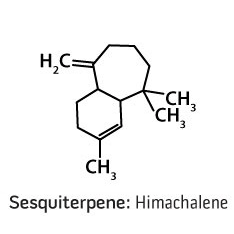Origin: a Latin derivative
meaning "Gift of the Earth."
Part 4: Terpene Hydrocarbons—Sesquiterpenes

Other varieties of terpenes form when additional isoprene units attach to a monoterpene. Sesquiterpenes are very similar to monoterpenes except for the one additional isoprene unit added to their structure for a total of 15 carbons. Because of their higher molecular weights, sesquiterpenes are less volatile than monoterpenes, and are therefore less prevalent in essential oils overall; however, they have unique properties that distinguish them from monoterpenes and make them important contributors to the synergistic functionality of essential oils. Common sesquiterpenes found in essential oils are cedrene, zingiberene, himachlene, and caryophyllene.
Main Health Effects:
- Cleansing1
- Digestive health2*
- Aides in healthy circulation3*
- Improves the appearance of skin4
- Promotes grounding and balance of emotions5
| Essential Oil | Main Sesquiterpene Constituent(s) | Amount |
| Cedarwood4,5 | cedrene, thujopsene | Approximately 70% |
| Patchouli4,5 | bulnesene, guaiene | Approximately 65% |
| Vetiver5 | vatirenene, seychellane, cubebene | Approximately 65% |
| Ginger2*,5 | zingiberene, sesquiphellandrene, curcumene | Approximately 55% |
| Ylang Ylang5 | germacrene, caryophyllene, farnesene | Approximately 55% |
| Myrrh1,2*,4,5 | myrrh sesquiterpenoid, elemene | Approximately 55% |
| Helichrysum4 | himachalene, curcumene | Approximately 40% |
| Melissa5 | germacrene, caryophyllene | Approximately 40% |
| Black Pepper3* | caryophyllene | Approximately 25% |





